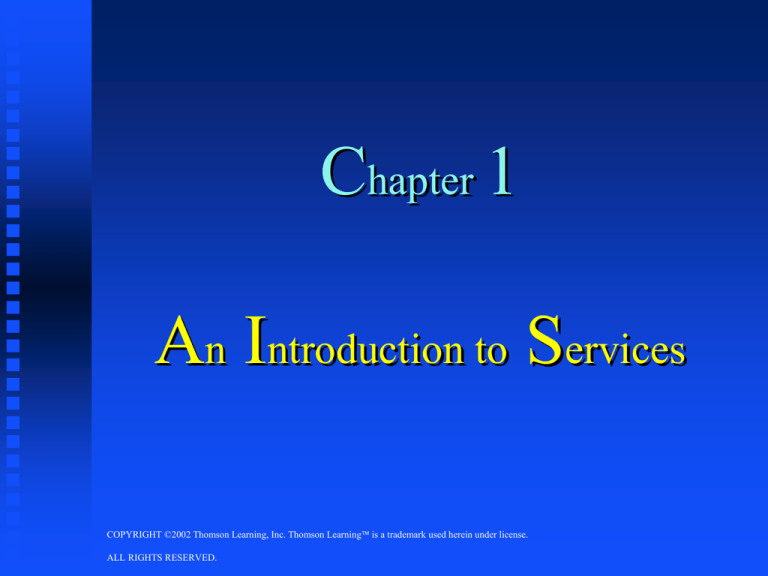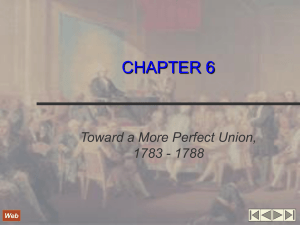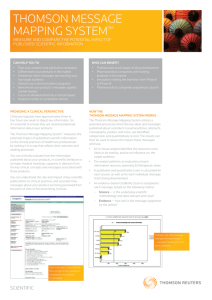
Chapter 1
An Introduction to Services
COPYRIGHT ©2002 Thomson Learning, Inc. Thomson Learning is a trademark used herein under license.
ALL RIGHTS RESERVED.
WHAT IS A SERVICE?
The Distinction is Unclear:
The Scale of Market Entities
&
The Molecular Model
COPYRIGHT ©2002 Thomson Learning, Inc. Thomson Learning is a trademark used herein under license.
ALL RIGHTS RESERVED.
WHAT IS A SERVICE?
In General:
Goods Objects, Devices, Things
Services Deeds, Efforts, Performances
COPYRIGHT ©2002 Thomson Learning, Inc. Thomson Learning is a trademark used herein under license.
ALL RIGHTS RESERVED.
THE BENEFIT CONCEPT
Encapsulation of benefits in the consumers
mind
Tide
Cleanliness
Whiteness
Motherhood
COPYRIGHT ©2002 Thomson Learning, Inc. Thomson Learning is a trademark used herein under license.
ALL RIGHTS RESERVED.
THE BENEFIT CONCEPT
Services deliver the bundle of benefits
through the experience that is created for
the consumer
The servuction model provides a
framework for understanding the
consumer’s experience
COPYRIGHT ©2002 Thomson Learning, Inc. Thomson Learning is a trademark used herein under license.
ALL RIGHTS RESERVED.
The Servuction Model
Inanimate
Environment
Invisible
organization
and systems
Invisible
Customer A
Contact
Personnel
Or
Service
Provider
Customer B
Visible
Bundle of service
benefits received
by Customer A
COPYRIGHT ©2002 Thomson Learning, Inc. Thomson Learning is a trademark used herein under license.
ALL RIGHTS RESERVED.
THE INCREASING DEMAND
FOR SERVICE KNOWLEDGE
Changes in management perspective
The
Industrial Model vs. The Market-focused
Model
Growth in service sector employment
Service sector contributions to the world
economy
Deregulation
COPYRIGHT ©2002 Thomson Learning, Inc. Thomson Learning is a trademark used herein under license.
ALL RIGHTS RESERVED.
THE DEMAND FOR KNOWLDEGE:
SERVICE SECTOR EMPLOYMENT
Service Sector
Employment:
78% in United States
73% in Great Britain
62% in Japan
57% in Germany
90% of All Jobs by
2020
New Job Creation:
80% of All New Jobs
(1980-1990)
90% of All New Jobs
(1990-2000)
88% of All Jobs by
2005
*42% of Work Force is Providing Some Form of Personal Service
COPYRIGHT ©2002 Thomson Learning, Inc. Thomson Learning is a trademark used herein under license.
ALL RIGHTS RESERVED.
THE DEMAND FOR KNOWLEDGE:
CONTRIBUTIONS TO THE ECONOMY
Economic impact:
The service sector accounts for over 70% of
the United States’ gross domestic product
(GDP)
The majority of industries in the U.S.
economy do not produce, they perform
COPYRIGHT ©2002 Thomson Learning, Inc. Thomson Learning is a trademark used herein under license.
ALL RIGHTS RESERVED.
THE DEMAND FOR KNOWLEDGE:
THE IMPACT OF DEREGULATION
Effect of Deregulations:
No demand for services knowledge when
demand exceeded supply and competitive
pressures were few
Between 1980-1992
U.S. airlines declined from 36 to 12
the number of trucking companies that failed during the
1980s was more than the previous 45 years combined
commercial banks declined by 14%
COPYRIGHT ©2002 Thomson Learning, Inc. Thomson Learning is a trademark used herein under license.
ALL RIGHTS RESERVED.
THE DEMAND FOR KNOWLEDGE:
THE IMPACT OF DEREGULATION
Effect of Deregulations (continued):
Knowledge is needed in nonprice issues:
customer
service
customer retention
image enhancement
transforming public contact personnel
into marketing-oriented personnel
COPYRIGHT ©2002 Thomson Learning, Inc. Thomson Learning is a trademark used herein under license.
ALL RIGHTS RESERVED.
THE INDUSTRIAL MODEL
Sales Revenues are a function of:
location
Strategies
sales Promotions
advertising
COPYRIGHT ©2002 Thomson Learning, Inc. Thomson Learning is a trademark used herein under license.
ALL RIGHTS RESERVED.
THE INDUSTRIAL MODEL
(continued)
Labor and operating costs should be kept
as low as possible
better
to rely on machines than humans
narrowly defined jobs
Leave little room for discretion
believes
most employees are indifferent,
unskilled, and incapable of completing
complex tasks.
performance expectations are low
wages are kept low
few opportunities for advancement
COPYRIGHT ©2002 Thomson Learning, Inc. Thomson Learning is a trademark used herein under license.
ALL RIGHTS RESERVED.
THE INDUSTRIAL MODEL
(continued)
Places a higher value on upper and middle
managers
Replaces full-time personnel with part-time
personnel to reduce costs
COPYRIGHT ©2002 Thomson Learning, Inc. Thomson Learning is a trademark used herein under license.
ALL RIGHTS RESERVED.
CONSEQUENCES OF
THE INDUSTRIAL MODEL
(employee)
Guarantees a cycle-of-failure
Encourages front-line personnel to be
indifferent to problems
no
opportunity for advancement (dead-end
jobs)
poor pay
some companies let employees go before mandatory
raises
COPYRIGHT ©2002 Thomson Learning, Inc. Thomson Learning is a trademark used herein under license.
ALL RIGHTS RESERVED.
CONSEQUENCES OF
THE INDUSTRIAL MODEL
(employee)
poor pay has created a new class of migrant worker
16 million people now travel from one short-term
job to another
superficial
training
focuses only on product knowledge
little, if any, company benefits
Prohibits employees from taking
discretionary action
High employee turnover rate
COPYRIGHT ©2002 Thomson Learning, Inc. Thomson Learning is a trademark used herein under license.
ALL RIGHTS RESERVED.
CONSEQUENCES
OF THE INDUSTRIAL MODEL
(customers)
Customer dissatisfaction
2/3
of customer’s defect, not due to the product,
but due to the unhelpfulness of the provider
flat and declining sales revenues
Overall the industrial approach is bad for:
employees
customers
shareholders
country
COPYRIGHT ©2002 Thomson Learning, Inc. Thomson Learning is a trademark used herein under license.
ALL RIGHTS RESERVED.
THE MARKET-FOCUSED
MANAGEMENT MODEL
Purpose of the firm is to serve the customer
Service delivery is the focus of the system
and the overall differential advantage in
terms of competitive advantage
The services triangle provides a framework
for the services model
COPYRIGHT ©2002 Thomson Learning, Inc. Thomson Learning is a trademark used herein under license.
ALL RIGHTS RESERVED.
THE SERVICES TRIANGLE
•The company
exists to serve
the customer
The
service
strategy
•The organization
exists to serve the
needs of the people
who serve the
customer
The
customer
The
systems
COPYRIGHT ©2002 Thomson Learning, Inc. Thomson Learning is a trademark used herein under license.
ALL RIGHTS RESERVED.
The
people
THE SERVICES TRIANGLE
1. Communicate the service strategy to the customer
2. Customer/employee interaction:
greatest
opportunity for gains and losses
moments-of-truth
critical
incidents
3. Customer/procedures & physical hardware
A.T.M. machines
cramped airline seats
COPYRIGHT ©2002 Thomson Learning, Inc. Thomson Learning is a trademark used herein under license.
ALL RIGHTS RESERVED.
THE SERVICES TRIANGLE
4. Organizational systems may prevent
employees from giving good service
5. Physical and administrative systems
should flow logically from the service
strategy
6. Good service starts at the top
*MGT. should “Walk What They Talk” and provide:
-sense of focus
-clarity
-priorities
COPYRIGHT ©2002 Thomson Learning, Inc. Thomson Learning is a trademark used herein under license.
ALL RIGHTS RESERVED.
CHARACTERISTICS OF THE
MARKET-FOCUSED MODEL
Believes employees want to do good work
invests
in people as much as machines
technology is used to assist people (not to
monitor there every activity)
data is made available to the front-line
COPYRIGHT ©2002 Thomson Learning, Inc. Thomson Learning is a trademark used herein under license.
ALL RIGHTS RESERVED.
CHARACTERISTICS OF THE
MARKET-FOCUSED MODEL
(continued)
Recognizes that employee turnover and
customer satisfaction are closely related
tie
pay to performance
focus on selection and training of personnel
Ryder Truck
no training (41% turnover)
received training (19% turnover)
better
trained, provide better service, require
less supervision
COPYRIGHT ©2002 Thomson Learning, Inc. Thomson Learning is a trademark used herein under license.
ALL RIGHTS RESERVED.
CHARACTERISTICS OF THE
MARKET-FOCUSED MODEL
(continued)
Employ more full-time employees
better
for customers and employees
companies that pay more are finding that as a
percentage of sales, labor costs are actually
lower than industry averages
COPYRIGHT ©2002 Thomson Learning, Inc. Thomson Learning is a trademark used herein under license.
ALL RIGHTS RESERVED.







